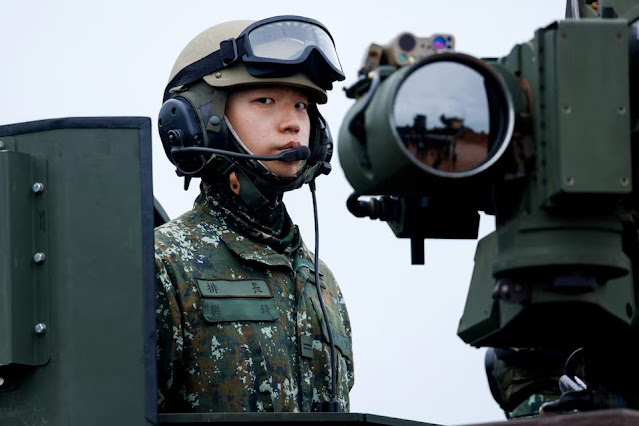- Get link
- X
- Other Apps
- Get link
- X
- Other Apps
Taiwan unveiled its first batch of U.S.-supplied M1A2T Abrams tanks during annual military exercises aimed at showcasing its readiness to counter threats from China. On Thursday, four of these modern battle tanks conducted live-fire demonstrations in Hsinchu county, maneuvering through muddy terrain and striking targets as President Lai Ching-te looked on. Lai praised the tanks' capabilities in firepower and mobility, calling them “undoubtedly the strongest tank on the battlefield,” and said the military's growing strength enhances national security.
See also: South Korea’s Ex-President Yoon Suk Yeol Re-Arrested for 2024 Martial Law Plot
These drills form part of a larger 10-day Han Kuang exercise that simulates real conflict scenarios across land, air, and sea. The drills aim to demonstrate Taiwan’s preparedness for a Chinese invasion and reassure its international partners, especially the United States, which supplies most of its advanced weaponry. The delivery of 38 Abrams tanks in December marked Taiwan’s first acquisition of new tanks in 24 years. A total of 108 tanks are scheduled for delivery by the end of next year.
Despite their battlefield strength, analysts caution that Abrams tanks, like others used in Ukraine, are increasingly vulnerable to drone and precision-strike attacks. Taiwan will need to invest in counter-drone measures and strategic placement to protect these high-value assets. According to military officials, the tanks are expected to enter full service later this year.
President Lai also tied the military’s preparedness to national unity and democratic resilience, especially ahead of a key recall election on July 26, which could reshape the legislative balance of power. Meanwhile, civil defense efforts such as evacuation drills in supermarkets are running parallel to military exercises to ensure public awareness and readiness. Taiwan’s National Security Council stresses that both the government and civilians must be prepared for various threat scenarios given growing regional tensions.
See also: China to Sign Southeast Asia Nuclear-Free Zone Treaty Soon
The appearance of Taiwan’s newly acquired Abrams tanks during its annual Han Kuang military drills reflects a dual strategy: boosting conventional defense while adapting to modern threats. The M1A2T Abrams tanks part of a U.S. arms deal were seen maneuvering and firing at targets, drawing praise from President Lai Ching-te, who emphasized their power and strategic value. He noted that “realistic combat training” would help integrate these tanks with drone systems and other innovative tactics.
Taiwanese defense officials say the tanks will be deployed strategically based on evolving threats, with a focus on countering China’s military pressure. China, which claims Taiwan as its territory, has significantly increased its air and sea activity around the island in recent years. Beijing dismissed Taiwan’s exercises as “nothing but a bluff,” but Taipei views them as critical to deterrence and international messaging.
However, modern warfare, particularly insights from the Russia-Ukraine conflict, suggests that even advanced tanks like the Abrams are not invulnerable. Both Russian and Ukrainian tanks including U.S.-supplied ones have been destroyed by drones and anti-tank weapons. Experts argue that Taiwan must adapt by deploying counter-drone systems or stationing tanks in elevated, protected positions.
Thomas Lim, a scholar from Singapore’s Rajaratnam School of International Studies, acknowledged the complexity of defending these “prized assets,” but said this challenge is not unique to Taiwan. The military's emphasis is now on integration, mobility, and layered defense.
Simultaneously, Taiwan is running civilian preparedness drills to build societal resilience. Supermarkets like PX Mart held evacuation simulations with customers taking shelter during simulated air raids. Lin Fei-fan of the National Security Council highlighted that readiness must involve both government and civil society, reflecting the island’s comprehensive approach to security amid rising regional tension and uncertainty over future conflict scenarios.
- Get link
- X
- Other Apps




Comments
Post a Comment